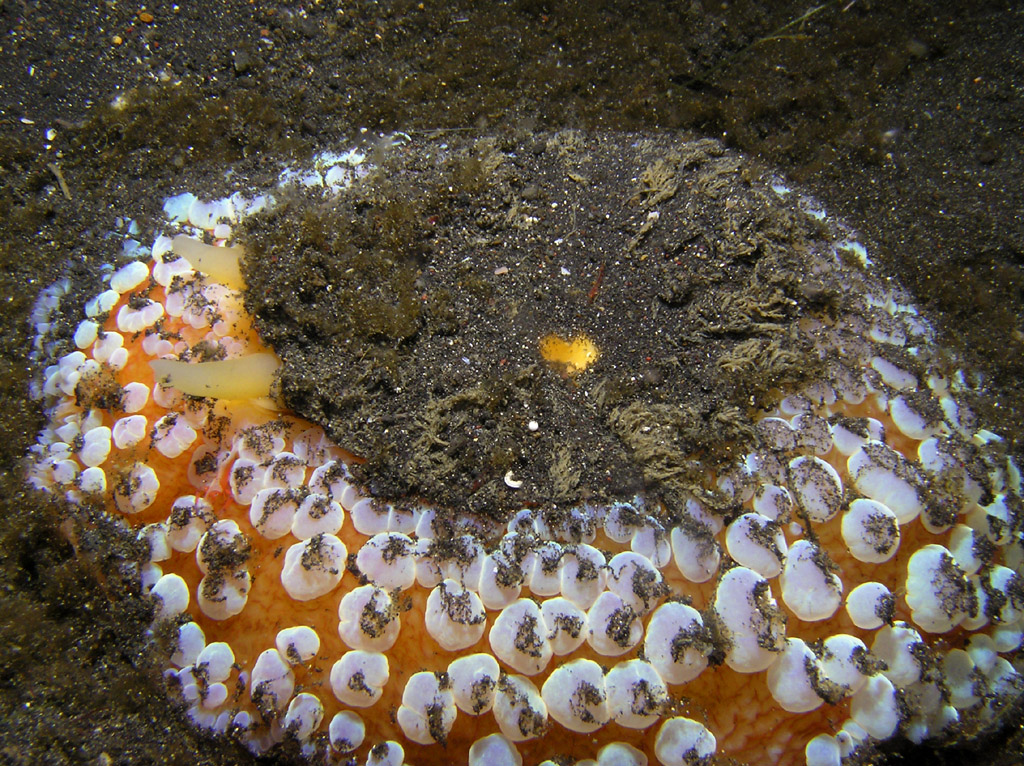 |
Umbraculum umbraculum
Digital PhotographPhotograph courtesy of the Webmaster
Lembeh Straits, Indonesia
March, 2004
Umbraculum umbraculum (Lightfoot, 1786)
Umbraculum is truly one of the oddest opisthobranchs I have seen. To begin with it is one of the Pleurobranchs, or side gilled sea slugs. While all other pleurobranchs, except Tylodina have retained a thin internal shell, these two more primitive genera have an external shell. Because the animal has no means to keep the shell clean of growth of other encrusting animals, specimens often carry quite a collection of animals, such as sponges and anemones and sometimes even algae and other assorted grunge on the shell surface. Webmaster Mike's shot above, taken in Lembeh Strait, Sulawesi, Indonesia, on a night dive in only 20 feet of water shows a pretty typical assemblage of algae, diatoms and possibly some hydroids on board.
Below the shell the body is covered with large pustules. The ground color of the body can very widely, but the pustules are usually white. The rhinophores are rolled and protrude from under the shell. Specimens may reach 14 cc (5.5 inches) in length. The eyes and rolled rhinophores can be seen in images submitted by Mary Jane Adams to Bill Rudman's Sea Slug Forum. Interestly enough, they were also taken in the Lembeh Straits area.
Rudman's Sea Slug Forum reports this species as being widespread in tropical to warm temperate Indo-West Pacific. Ali Hermosillo has documented the species from Panama and also from Bahia de Banderas , Pacific Coast of Mexico. The animal has also been photographed in Hawaii by John Hoover as part of a previous BOW on Umbraculum umbraculum back in 1998. Umbraculum ovale P. P. Carpenter, 1856 described from West America, is thought to be a synonym of Umbraculum umbraculum .
The Mediterranean species, Umbraculum mediterraneum has been reported from Florida.
Umbraculum feed on sponges. They have a very wide radula to rasp away at their sponge prey. In the Indo-Pacific they have been observed to feed on species of the Demospongia , including Tethya spp., Aaptos aaptos, Ancorina alata, and Plakina trilopha . Interestingly, this species has a very wide depth range being found from the shallows of the intertidal zone all the way to 890 feet (274 m) depths.
Danville, Calif
Apr. 2004
Webmaster's Notes: This was my second all "digital" dive trip and I'm quite happy to report that it was a complete sucess! The " strobe problem" mentioned in my trip to Tulamben last October was solved by buying a pair of Inon D-180S strobes for use with my housed Olympus 750 UZ. One to use "over the top" and the second as a backup although there never was a need for a backup as the D-180S performed flawlessly. Little in the way of photo editing was required to put together a slide show while still "on location". Sure is nice to come home without film to process and digitize! Great saving in money also, estimated $300 in my case which was applied toward the purchase of one Inon D-180S strobe at $425 US. For all you Olympus "point and shoot" U/W photographers, I would very definitely look into this strobe for macro applications.
Some thoughts on Kingkungan Bay Resort where we stayed. As some of you may or may not know, the resort is in transition due to competition from other dive operations in the Lembeh Straits, in particular the new Murex resort across the way that hired away many of KBR's better dive guides. ECO Divers based in Manado have taken over day to day operation of the resort. They have two immediate problems at hand: (1) Price competition (2) Deferred maintenance on the resort. In the way of a good news scenario, the lower prices mean "economy " minded divers like myself could finally make the trip, the bad news is that the area is very likely to be "over dived" with the influx of divers attracted by the lower prices. Marc Chamberlain (CHAMBO to California Divers) was able to get our small group a rate of about $140/day US for THREE DIVES, three meals, and lodging. Indeed a deal! Marc did a super job organizing the trip and putting us on all the hot spots while diving the straits.
Guess what I'm saying is that if you are entertaining plans to visit Lembeh Straits, I wouldn't put it off for too long!
Taxonomic information courtesy of:

David W. Behrens
Author:
Pacific Coast Nudibranchs
Send Dave mail at dave@seachallengers.com
|
